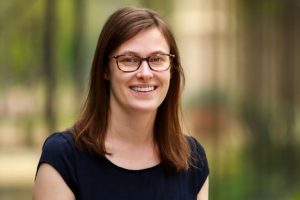
Eliza O’Reilly joins the Department of Applied Mathematics and Statistics as an assistant professor from the California Institute of Technology, where she was a postdoctoral fellow. In this Q&A she discusses her research in data science, probability theory, and statistical modeling.
Tell us a little about yourself.
I grew up near Pittsburgh, PA, and for my undergraduate degree, attended the University of Pittsburgh, where I majored in mathematics. I knew I wanted to go to graduate school after spending a semester abroad with the Budapest Semesters in Mathematics program, where I could take graduate-level courses and conduct research. I then moved to Texas for my PhD at UT Austin, followed by a postdoc at Caltech. Now I am very excited to begin a position here at Johns Hopkins.
Describe your research.
My research lies under the broad umbrella of mathematics of data science. This field aims to build mathematical frameworks and prove theoretical guarantees for algorithms that extract information from data. My work utilizes theory from stochastic and convex geometry to understand the performance and efficiency of learning algorithms and to develop new kinds of structured model classes for use in data science applications. Convex sets and stochastic geometric models such as random tessellations are ubiquitous in algorithms used for data analysis. Their geometric structure and distributional properties often govern the complexity and generalization performance of the associated models.
Randomized decision trees, for example, are used to build prediction models and generate random tessellations that partition the feature space into convex polyhedral cells. The model’s generalization error can then be controlled by appropriately balancing the size and number of these cells.
What drew you to this field and focus area?
I took a class in stochastic geometry in my first year of graduate school and enjoyed thinking about and working with this set of theoretical tools and models. The course’s instructor, Professor Francois Baccelli, became my advisor, and I spent the rest of my PhD studying stochastic geometric models such as determinantal point processes, Poisson hyperplane tessellations, and random convex sets. Along the way, I became interested in the applications of these probabilistic models to modern data science applications. I was inspired to help improve the interpretability and safety of algorithms used to learn from complex modern data sets. I found that stochastic and convex geometry tools from my PhD gave some applications a new perspective, leading to many open questions that I want to investigate.
What are some real-world applications of your research.
My work on random tessellations tries to understand and improve algorithms that utilize random partitions of a data set. This includes randomized decision trees and forest algorithms which are widely used in industry and science to build models for making predictions from data. They are particularly appealing to practitioners in health care and engineering, where it is important to understand which features are most relevant to the algorithm’s output. Also, my research on convex regression and regularization have applications in settings where one would like to incorporate shape constraints on the model due to prior knowledge or computational considerations. These include applications in economics where economic principles manifest in convex or monotone relationships between parameters that the model should preserve. Another example is engineering design, where enforcing convexity in a model describing the relationship between design parameters ensures the computational efficiency of the subsequent optimization problem.
What are some of your goals for this first year at JHU?
I hope to begin collaborations within and outside the department, and I am particularly excited about opportunities to collaborate with researchers at the SNF AGORA Institute and the medical school. Another goal I have is to introduce graduate students to the field of stochastic geometry by teaching a course and beginning to work with students on projects related to this research area.
Anything else we should know? Any fun facts?
Outside the department, you’ll most likely find me trying out a new restaurant or coffee shop, attending a concert or music festival, visiting a modern art gallery, or enjoying the outdoors on a hike.
Also, when I lived in Austin, I volunteered for the Texas Civil Rights Project, a non-profit of lawyers that bring cases around the state to improve voting access and challenge gerrymandered voting district maps. In 2020 I was an expert witness in a successful case that prevented election administrators from decreasing the number of polling locations in their county.